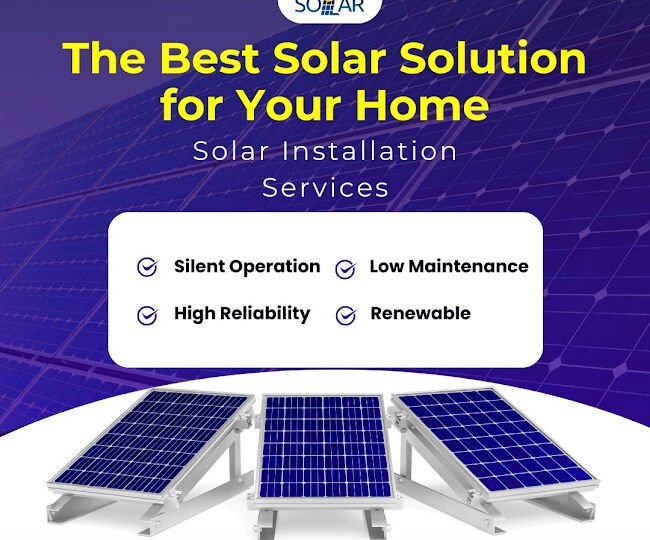

The Growing Accessibility of Solar Energy
The adoption of solar energy is no longer reserved for just large corporations or wealthy homeowners. Advances in solar technology and a growing network of government incentives have made solar energy more accessible to people from all walks of life.
1. Solar Panels for All Types of Homes and Businesses
With a variety of solar solutions available, whether it’s for a residential rooftop, a commercial building, or a large industrial operation, solar energy is adaptable to virtually any setting. Homeowners can install rooftop solar panels, while businesses can benefit from large-scale solar systems or even solar canopies in parking lots to generate energy and reduce costs.
Additionally, new innovations such as solar windows and solar roof tiles are helping to make solar energy even more accessible. These technologies allow for the integration of solar energy generation into building designs without the need for bulky, traditional panels. The design and aesthetic flexibility of these newer systems mean that homeowners and businesses don’t have to sacrifice visual appeal to benefit from solar energy.
2. Affordable Financing Options
Another factor contributing to the growing accessibility of solar energy is the availability of financing options. From leasing and power purchase agreements (PPAs) to solar loans, individuals and businesses can now invest in solar systems with little to no upfront cost. With these financing options, the cost of solar installations can be spread over several years, and many users find that the savings on their energy bills more than offset the cost of the system.
Solar Energy’s Role in the Global Energy Transition
The global shift toward cleaner, renewable energy sources is crucial in mitigating climate change and ensuring a sustainable future. Solar energy is expected to play a key role in this transition due to its scalability and versatility. Here’s how:
1. Reducing Global Dependence on Fossil Fuels
Countries that rely heavily on fossil fuels for energy generation are beginning to make the transition to solar power. As the price of solar panels continues to drop and the technology becomes more efficient, governments are investing heavily in solar infrastructure, not only for environmental reasons but also for energy security. The shift to solar reduces dependence on imported oil and natural gas, allowing countries to produce their own energy and reduce their vulnerability to energy price fluctuations.
2. Solar as a Key Component of the Energy Mix
While solar energy alone may not be sufficient to meet the entire global demand for electricity, it is a crucial part of the clean energy mix that will power the world in the future. Combined with other renewable sources like wind, hydro, and geothermal energy, solar power can provide the consistent, sustainable energy needed to replace fossil fuels and reduce the environmental impacts of conventional energy generation.
3. Solar in Developing Countries
In regions where electricity access is limited or nonexistent, solar energy offers an ideal solution. Off-grid solar systems, including solar lanterns, mini-grids, and even solar-powered water pumps, are transforming lives in rural areas of developing countries. These solutions are affordable, easy to install, and provide reliable access to electricity, improving education, healthcare, and economic opportunities in underserved communities.
International organizations, NGOs, and private enterprises are increasingly focused on deploying solar solutions in these regions, providing life-changing opportunities for millions of people.
Technological Innovations Driving Solar Energy
The solar industry continues to evolve, with several emerging technologies expected to improve solar power generation, storage, and efficiency in the coming years.
1. Solar Batteries for Energy Storage
One of the main challenges with solar power is that energy generation is intermittent—solar panels only produce electricity when the sun is shining. However, the development of advanced energy storage systems, such as lithium-ion batteries, is helping to address this issue. Solar batteries store excess power generated during the day, which can then be used at night or during cloudy periods. This makes solar power a more reliable and consistent source of energy.
2. Bifacial Solar Panels
Bifacial solar panels are a newer technology that can generate power from both sides of the panel. These panels capture sunlight that is reflected off surfaces like rooftops or the ground, increasing energy production. Bifacial panels can improve the efficiency of solar systems by 10 to 30%, which makes them a highly attractive option for both residential and commercial solar installations.
3. Floating Solar Farms
In some regions, land for traditional solar farms may be limited. Floating solar farms, which are installed on bodies of water such as lakes or reservoirs, are an innovative solution to this problem. These floating panels not only provide renewable energy but also help conserve water by reducing evaporation. As floating solar farms gain popularity, they could become an important part of the global solar landscape.
4. Perovskite Solar Cells
Perovskite solar cells are a newer generation of solar technology that offers the potential for much cheaper and more efficient solar panels. These cells are made from materials that can absorb light more efficiently than traditional silicon-based panels. Though still in the experimental phase, perovskite solar cells have the potential to revolutionize the solar energy industry by significantly reducing costs while increasing energy efficiency.
Conclusion: The Solar Energy Revolution is Now
Solar energy is more than just an alternative—it is becoming the backbone of a cleaner, more sustainable global energy future. The benefits of solar power are clear: it saves money, reduces carbon footprints, and helps create a sustainable energy ecosystem. As technology advances and costs continue to decrease, solar power is becoming increasingly accessible to people around the world.
Whether you are a homeowner looking to reduce your energy bills, a business aiming to cut operational costs, or someone passionate about reducing your environmental impact, investing in solar energy is one of the most effective choices you can make.
The transition to solar energy is not just about a single solar panel on a roof—it is a global movement towards a cleaner, greener planet. By embracing solar energy today, we can help create a brighter, more sustainable future for generations to come.

